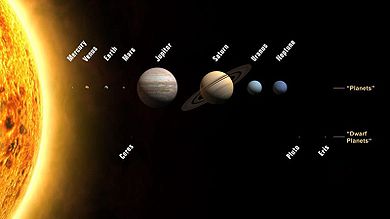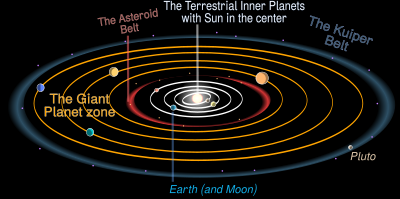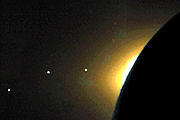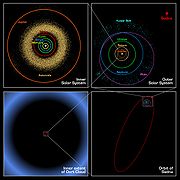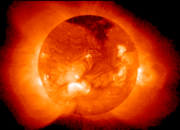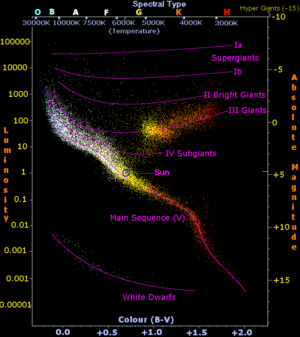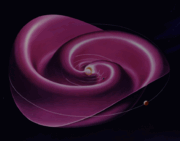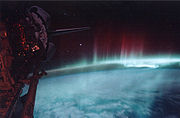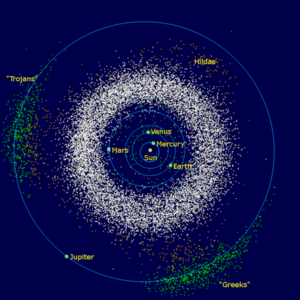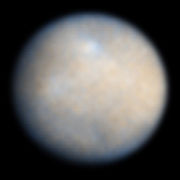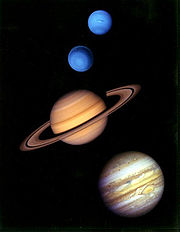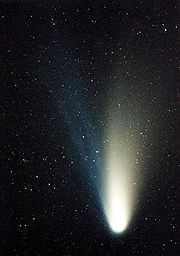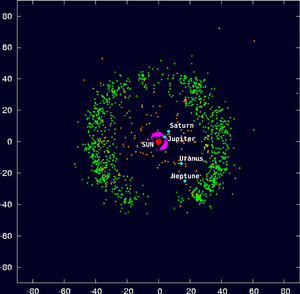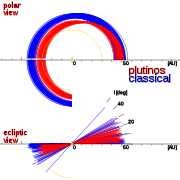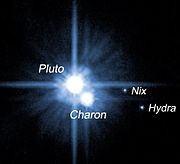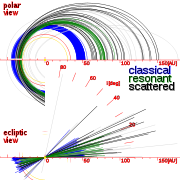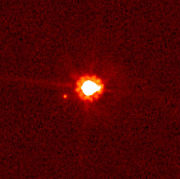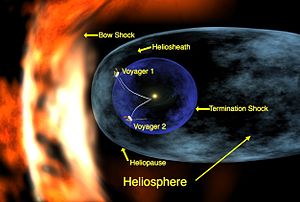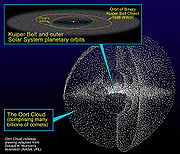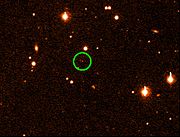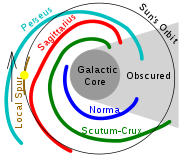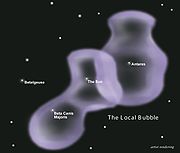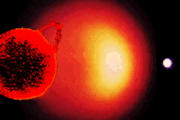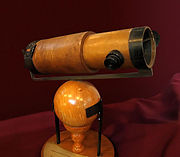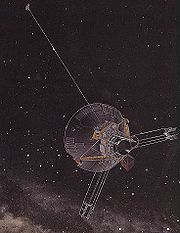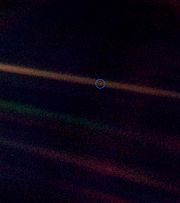
Solar System
Background Information
SOS Children have produced a selection of wikipedia articles for schools since 2005. Sponsor a child to make a real difference.
The Solar System consists of the Sun and those celestial objects bound to it by gravity. These objects are the eight planets and their 166 known moons, four dwarf planets and billions of small bodies, including asteroids, icy Kuiper belt objects, comets, meteoroids, and interplanetary dust.
These objects are grouped in a number of distinct regions. Moving outwards from the Sun, the major components are four terrestrial inner planets, an asteroid belt, four gas giant outer planets, the Kuiper belt, the scattered disc, and ultimately the hypothetical Oort cloud. A stream of charged particles from the Sun, called the solar wind, defines the heliosphere which permeates the Solar System out to around the scattered disc.
In order of their distances from the Sun, the eight planets are:
Four smaller objects are classified as dwarf planets as of mid-2008, though the list is expected to grow:
Six of the planets and two of the dwarf planets are in turn orbited by natural satellites, usually termed "moons" after Earth's Moon, and each of the outer planets is encircled by planetary rings of dust and other particles.
Terminology
Objects orbiting the Sun are divided into three classes: planets, dwarf planets, and small Solar System bodies.
On August 24, 2006, the International Astronomical Union defined the term "planet" for the first time, prompted by the discovery of Eris and subsequent discussions over its classification. A planet is any body in orbit around the Sun that has enough mass to form itself into a spherical shape and has cleared its immediate neighbourhood of all smaller objects. By this definition, the Solar System has eight known planets: Mercury, Venus, Earth, Mars, Jupiter, Saturn, Uranus, and Neptune. Pluto was demoted from planetary status, as it has not cleared its orbit of surrounding Kuiper belt objects.
A dwarf planet, as defined by the International Astronomical Union (IAU), is a celestial body orbiting the Sun that is massive enough to be rounded by its own gravity but which has not cleared its neighbouring region of planetesimals and is not a satellite. By this definition, the Solar System has four known dwarf planets: Ceres, Pluto, Makemake, and Eris. Other objects that may become classified as dwarf planets are Sedna, Orcus, and Quaoar. Dwarf planets that orbit in the trans-Neptunian region are called " plutoids."
The remainder of the objects in orbit around the Sun are small Solar System bodies (SSSBs).
Natural satellites, or moons, are those objects in orbit around planets, dwarf planets and SSSBs, rather than the Sun itself.
Astronomers usually measure distances within the Solar System in astronomical units (AU). One AU is the approximate distance between the Earth and the Sun, or roughly 149,598,000 km (93,000,000 mi). Pluto is roughly 38 AU from the Sun while Jupiter lies at roughly 5.2 AU. One light-year, the best known unit of interstellar distance, is roughly 63,240 AU. A body's distance from the Sun varies in the course of its year. Its closest approach to the Sun is called its perihelion, while its farthest distance from the Sun is called its aphelion.
Informally, the Solar System is sometimes divided into separate zones. The inner Solar System includes the four terrestrial planets and the main asteroid belt. Some define the outer Solar System as comprising everything beyond the asteroids. Since the discovery of the Kuiper belt, others define it as the region beyond Neptune, with the four gas giants considered a separate "middle zone".
Layout and structure
The principal component of the Solar System is the Sun, a main sequence G2 star that contains 99.86 percent of the system's known mass and dominates it gravitationally. Jupiter and Saturn, the Sun's two largest orbiting bodies, account for more than 90 percent of the system's remaining mass.
Most large objects in orbit around the Sun lie near the plane of Earth's orbit, known as the ecliptic. The planets are very close to the ecliptic while comets and Kuiper belt objects are usually at significantly greater angles to it.
All of the planets and most other objects also orbit with the Sun's rotation (counter-clockwise, as viewed from above the Sun's north pole). There are exceptions, such as Halley's Comet.
Objects travel around the Sun following Kepler's laws of planetary motion. Each object orbits along an approximate ellipse with the Sun at one focus of the ellipse. The closer an object is to the Sun, the faster it moves. The orbits of the planets are nearly circular, but many comets, asteroids and objects of the Kuiper belt follow highly elliptical orbits.
To cope with the vast distances involved, many representations of the Solar System show orbits the same distance apart. In reality, with a few exceptions, the farther a planet or belt is from the Sun, the larger the distance between it and the previous orbit. For example, Venus is approximately 0.33 AU farther out than Mercury, while Saturn is 4.3 AU out from Jupiter, and Neptune lies 10.5 AU out from Uranus. Attempts have been made to determine a correlation between these orbital distances (see Titius-Bode law), but no such theory has been accepted.
Sun
The Sun is the Solar System's parent star, and far and away its chief component. Its large mass gives it an interior density high enough to sustain nuclear fusion, which releases enormous amounts of energy, mostly radiated into space as electromagnetic radiation such as visible light.
The Sun is classified as a moderately large yellow dwarf, but this name is misleading as, compared to stars in our galaxy, the Sun is rather large and bright. Stars are classified by the Hertzsprung-Russell diagram, a graph which plots the brightness of stars against their surface temperatures. Generally, hotter stars are brighter. Stars following this pattern are said to be on the main sequence; the Sun lies right in the middle of it. However, stars brighter and hotter than the Sun are rare, while stars dimmer and cooler are common.
It is believed that the Sun's position on the main sequence puts it in the "prime of life" for a star, in that it has not yet exhausted its store of hydrogen for nuclear fusion. The Sun is growing brighter; early in its history it was 75 percent as bright as it is today.
Calculations of the ratios of hydrogen and helium within the Sun suggest it is halfway through its life cycle. It will eventually move off the main sequence and become larger, brighter, cooler and redder, becoming a red giant in about five billion years. At that point its luminosity will be several thousand times its present value.
The Sun is a population I star; it was born in the later stages of the universe's evolution. It contains more elements heavier than hydrogen and helium (" metals" in astronomical parlance) than older population II stars. Elements heavier than hydrogen and helium were formed in the cores of ancient and exploding stars, so the first generation of stars had to die before the universe could be enriched with these atoms. The oldest stars contain few metals, while stars born later have more. This high metallicity is thought to have been crucial to the Sun's developing a planetary system, because planets form from accretion of metals.
Interplanetary medium
Along with light, the Sun radiates a continuous stream of charged particles (a plasma) known as the solar wind. This stream of particles spreads outwards at roughly 1.5 million kilometres per hour, creating a tenuous atmosphere (the heliosphere) that permeates the Solar System out to at least 100 AU (see heliopause). This is known as the interplanetary medium. Geomagnetic storms on the Sun's surface, such as solar flares and coronal mass ejections, disturb the heliosphere, creating space weather. The Sun's rotating magnetic field acts on the interplanetary medium to create the heliospheric current sheet, the largest structure in the solar system.
Earth's magnetic field protects its atmosphere from interacting with the solar wind. Venus and Mars do not have magnetic fields, and the solar wind causes their atmospheres to gradually bleed away into space. The interaction of the solar wind with Earth's magnetic field creates the aurorae seen near the magnetic poles.
Cosmic rays originate outside the Solar System. The heliosphere partially shields the Solar System, and planetary magnetic fields (for those planets that have them) also provide some protection. The density of cosmic rays in the interstellar medium and the strength of the Sun's magnetic field change on very long timescales, so the level of cosmic radiation in the Solar System varies, though by how much is unknown.
The interplanetary medium is home to at least two disc-like regions of cosmic dust. The first, the zodiacal dust cloud, lies in the inner Solar System and causes zodiacal light. It was likely formed by collisions within the asteroid belt brought on by interactions with the planets. The second extends from about 10 AU to about 40 AU, and was probably created by similar collisions within the Kuiper belt.
Inner Solar System
The inner Solar System is the traditional name for the region comprising the terrestrial planets and asteroids. Composed mainly of silicates and metals, the objects of the inner Solar System huddle very closely to the Sun; the radius of this entire region is shorter than the distance between Jupiter and Saturn.
Inner planets
The four inner or terrestrial planets have dense, rocky compositions, few or no moons, and no ring systems. They are composed largely of minerals with high melting points, such as the silicates which form their crusts and mantles, and metals such as iron and nickel, which form their cores. Three of the four inner planets (Venus, Earth and Mars) have substantial atmospheres; all have impact craters and tectonic surface features such as rift valleys and volcanoes. The term inner planet should not be confused with inferior planet, which designates those planets which are closer to the Sun than Earth is (i.e. Mercury and Venus).
- Mercury
- Mercury (0.4 AU) is the closest planet to the Sun and the smallest planet (0.055 Earth masses). Mercury has no natural satellites, and its only known geological features besides impact craters are lobed ridges or rupes, probably produced by a period of contraction early in its history. Mercury's almost negligible atmosphere consists of atoms blasted off its surface by the solar wind. Its relatively large iron core and thin mantle have not yet been adequately explained. Hypotheses include that its outer layers were stripped off by a giant impact, and that it was prevented from fully accreting by the young Sun's energy.
- Venus
- Venus (0.7 AU) is close in size to Earth, (0.815 Earth masses) and like Earth, has a thick silicate mantle around an iron core, a substantial atmosphere and evidence of internal geological activity. However, it is much drier than Earth and its atmosphere is ninety times as dense. Venus has no natural satellites. It is the hottest planet, with surface temperatures over 400 °C, most likely due to the amount of greenhouse gases in the atmosphere. No definitive evidence of current geological activity has been detected on Venus, but it has no magnetic field that would prevent depletion of its substantial atmosphere, which suggests that its atmosphere is regularly replenished by volcanic eruptions.
- Earth
- Earth (1 AU) is the largest and densest of the inner planets, the only one known to have current geological activity, and the only planet known to have life. Its liquid hydrosphere is unique among the terrestrial planets, and it is also the only planet where plate tectonics has been observed. Earth's atmosphere is radically different from those of the other planets, having been altered by the presence of life to contain 21% free oxygen. It has one natural satellite, the Moon, the only large satellite of a terrestrial planet in the Solar System.
- Mars
- Mars (1.5 AU) is smaller than Earth and Venus (0.107 Earth masses). It possesses a tenuous atmosphere of mostly carbon dioxide. Its surface, peppered with vast volcanoes such as Olympus Mons and rift valleys such as Valles Marineris, shows geological activity that may have persisted until very recently. Its red colour comes from rust in its iron-rich soil. Mars has two tiny natural satellites ( Deimos and Phobos) thought to be captured asteroids.
Asteroid belt
Asteroids are mostly small Solar System bodies composed mainly of rocky and metallic non-volatile minerals.
The main asteroid belt occupies the orbit between Mars and Jupiter, between 2.3 and 3.3 AU from the Sun. It is thought to be remnants from the Solar System's formation that failed to coalesce because of the gravitational interference of Jupiter.
Asteroids range in size from hundreds of kilometres across to microscopic. All asteroids save the largest, Ceres, are classified as small Solar System bodies, but some asteroids such as Vesta and Hygieia may be reclassed as dwarf planets if they are shown to have achieved hydrostatic equilibrium.
The asteroid belt contains tens of thousands, possibly millions, of objects over one kilometre in diameter. Despite this, the total mass of the main belt is unlikely to be more than a thousandth of that of the Earth. The main belt is very sparsely populated; spacecraft routinely pass through without incident. Asteroids with diameters between 10 and 10-4 m are called meteoroids.
- Ceres
- Ceres (2.77 AU) is the largest body in the asteroid belt and is classified as a dwarf planet. It has a diameter of slightly under 1000 km, large enough for its own gravity to pull it into a spherical shape. Ceres was considered a planet when it was discovered in the 19th century, but was reclassified as an asteroid in the 1850s as further observation revealed additional asteroids. It was again reclassified in 2006 as a dwarf planet.
- Asteroid groups
- Asteroids in the main belt are divided into asteroid groups and families based on their orbital characteristics. Asteroid moons are asteroids that orbit larger asteroids. They are not as clearly distinguished as planetary moons, sometimes being almost as large as their partners. The asteroid belt also contains main-belt comets which may have been the source of Earth's water.
Trojan asteroids are located in either of Jupiter's L4 or L5 points (gravitationally stable regions leading and trailing a planet in its orbit); the term "Trojan" is also used for small bodies in any other planetary or satellite Lagrange point. Hilda asteroids are in a 2:3 resonance with Jupiter; that is, they go around the Sun three times for every two Jupiter orbits.
The inner Solar System is also dusted with rogue asteroids, many of which cross the orbits of the inner planets.
Mid Solar System
The middle region of the Solar System is home to the gas giants and their planet-sized satellites. Many short period comets, including the centaurs, also lie in this region. It is occasionally referred to as the "outer Solar System", although recently that term has been more often applied to the region beyond Neptune. The solid objects in this region are composed of a higher proportion of "ices" (water, ammonia, methane) than the rocky denizens of the inner Solar System.
Outer planets
The four outer planets, or gas giants (sometimes called Jovian planets), collectively make up 99 percent of the mass known to orbit the Sun. Jupiter and Saturn consist largely of hydrogen and helium. The bulk of Uranus and Neptune consist of “ices”, such as water, ammonia and methane. Some astronomers suggest they belong in their own category, “ice giants.” All four gas giants have rings, although only Saturn's ring system is easily observed from Earth. The term outer planet should not be confused with superior planet, which designates planets outside Earth's orbit (the outer planets and Mars).
- Jupiter
- Jupiter (5.2 AU), at 318 Earth masses, masses 2.5 times all the other planets put together. It is composed largely of hydrogen and helium. Jupiter's strong internal heat creates a number of semi-permanent features in its atmosphere, such as cloud bands and the Great Red Spot. Jupiter has sixty-three known satellites. The four largest, Ganymede, Callisto, Io, and Europa, show similarities to the terrestrial planets, such as volcanism and internal heating. Ganymede, the largest satellite in the Solar System, is larger than Mercury.
- Saturn
- Saturn (9.5 AU), famous for its extensive ring system, has similarities to Jupiter, such as its atmospheric composition. Saturn is far less massive, being only 95 Earth masses. Saturn has sixty known satellites (and three unconfirmed); two of which, Titan and Enceladus, show signs of geological activity, though they are largely made of ice. Titan is larger than Mercury and the only satellite in the Solar System with a substantial atmosphere.
- Uranus
- Uranus (19.6 AU), at 14 Earth masses, is the lightest of the outer planets. Uniquely among the planets, it orbits the Sun on its side; its axial tilt is over ninety degrees to the ecliptic. It has a much colder core than the other gas giants, and radiates very little heat into space. Uranus has twenty-seven known satellites, the largest ones being Titania, Oberon, Umbriel, Ariel and Miranda.
- Neptune
- Neptune (30 AU), though slightly smaller than Uranus, is more massive (equivalent to 17 Earths) and therefore more dense. It radiates more internal heat, but not as much as Jupiter or Saturn. Neptune has thirteen known satellites. The largest, Triton, is geologically active, with geysers of liquid nitrogen. Triton is the only large satellite with a retrograde orbit. Neptune is accompanied in its orbit by a number of minor planets, termed Neptune Trojans, that are in 1:1 resonance with it.
Comets
Comets are small Solar System bodies, usually only a few kilometres across, composed largely of volatile ices. They have highly eccentric orbits, generally a perihelion within the orbits of the inner planets and an aphelion far beyond Pluto. When a comet enters the inner Solar System, its proximity to the Sun causes its icy surface to sublimate and ionise, creating a coma: a long tail of gas and dust often visible to the naked eye.
Short-period comets have orbits lasting less than two hundred years. Long-period comets have orbits lasting thousands of years. Short-period comets are believed to originate in the Kuiper belt, while long-period comets, such as Hale-Bopp, are believed to originate in the Oort cloud. Many comet groups, such as the Kreutz Sungrazers, formed from the breakup of a single parent. Some comets with hyperbolic orbits may originate outside the Solar System, but determining their precise orbits is difficult. Old comets that have had most of their volatiles driven out by solar warming are often categorised as asteroids.
- Centaurs
- The centaurs, which extend from 9 to 30 AU, are icy comet-like bodies that orbit in the region between Jupiter and Neptune. The largest known centaur, 10199 Chariklo, has a diameter of between 200 and 250 km. The first centaur discovered, 2060 Chiron, has been called a comet since it develops a coma just as comets do when they approach the Sun. Some astronomers classify centaurs as inward-scattered Kuiper belt objects along with the outward-scattered residents of the scattered disc.
Trans-Neptunian region
The area beyond Neptune, or the " trans-Neptunian region", is still largely unexplored. It appears to consist overwhelmingly of small worlds (the largest having a diameter only a fifth that of the Earth and a mass far smaller than that of the Moon) composed mainly of rock and ice. This region is sometimes known as the "outer Solar System", though others use that term to mean the region beyond the asteroid belt.
Kuiper belt
The Kuiper belt, the region's first formation, is a great ring of debris similar to the asteroid belt, but composed mainly of ice. It extends between 30 and 50 AU from the Sun. It is composed mainly of small Solar System bodies, but many of the largest Kuiper belt objects, such as Quaoar, Varuna, (136108) 2003 EL61 and Orcus, may be reclassified as dwarf planets. There are estimated to be over 100,000 Kuiper belt objects with a diameter greater than 50 km, but the total mass of the Kuiper belt is thought to be only a tenth or even a hundredth the mass of the Earth. Many Kuiper belt objects have multiple satellites, and most have orbits that take them outside the plane of the ecliptic.
The Kuiper belt can be roughly divided into the " classical" belt and the resonances. Resonances are orbits linked to that of Neptune (e.g. twice for every three Neptune orbits, or once for every two). The first resonance actually begins within the orbit of Neptune itself. The classical belt consists of objects having no resonance with Neptune, and extends from roughly 39.4 AU to 47.7 AU. Members of the classical Kuiper belt are classified as cubewanos, after the first of their kind to be discovered, (15760) 1992 QB1.
- Pluto and Charon
- Pluto (39 AU average), a dwarf planet, is the largest known object in the Kuiper belt. When discovered in 1930, it was considered to be the ninth planet; this changed in 2006 with the adoption of a formal definition of planet. Pluto has a relatively eccentric orbit inclined 17 degrees to the ecliptic plane and ranging from 29.7 AU from the Sun at perihelion (within the orbit of Neptune) to 49.5 AU at aphelion.
- It is unclear whether Charon, Pluto's largest moon, will continue to be classified as such or as a dwarf planet itself. Both Pluto and Charon orbit a barycenter of gravity above their surfaces, making Pluto-Charon a binary system. Two much smaller moons, Nix and Hydra, orbit Pluto and Charon.
- Pluto lies in the resonant belt and has a 3:2 resonance with Neptune, meaning that Pluto orbits twice round the Sun for every three Neptunian orbits. Kuiper belt objects whose orbits share this resonance are called plutinos.
- Makemake
- Makemake is the largest classical KBO, is the brightest object in the Kuiper belt after Pluto. Originally designated 2005 FY9, it was granted a name (and the status of dwarf planet) on July 11, 2008. Makemake's orbit is far more inclined than Pluto's (29°) and, unlike Pluto, as a classical KBO, its orbit is not affected by Neptune.
Scattered disc
The scattered disc overlaps the Kuiper belt but extends much further outwards. This region is thought to be the source of short-period comets. Scattered disc objects are believed to have been ejected into erratic orbits by the gravitational influence of Neptune's early outward migration. Most scattered disc objects (SDOs) have perihelia within the Kuiper belt but aphelia as far as 150 AU from the Sun. SDOs' orbits are also highly inclined to the ecliptic plane, and are often almost perpendicular to it. Some astronomers consider the scattered disc to be merely another region of the Kuiper belt, and describe scattered disc objects as "scattered Kuiper belt objects."
- Eris
- Eris (68 AU average) is the largest known scattered disc object, and caused a debate about what constitutes a planet, since it is at least 5% larger than Pluto with an estimated diameter of 2400 km (1500 mi). It is the largest of the known dwarf planets. It has one moon, Dysnomia. Like Pluto, its orbit is highly eccentric, with a perihelion of 38.2 AU (roughly Pluto's distance from the Sun) and an aphelion of 97.6 AU, and steeply inclined to the ecliptic plane.
Farthest regions
The point at which the Solar System ends and interstellar space begins is not precisely defined, since its outer boundaries are shaped by two separate forces: the solar wind and the Sun's gravity. The solar wind is believed to surrender to the interstellar medium at roughly four times Pluto's distance. However, the Sun's Roche sphere, the effective range of its gravitational influence, is believed to extend up to a thousand times farther.
Heliopause
The heliosphere is divided into two separate regions. The solar wind travels at its maximum velocity out to about 95 AU, or three times the orbit of Pluto. The edge of this region is the termination shock, the point at which the solar wind collides with the opposing winds of the interstellar medium. Here the wind slows, condenses and becomes more turbulent, forming a great oval structure known as the heliosheath that looks and behaves very much like a comet's tail, extending outward for a further 40 AU at its stellar-windward side, but tailing many times that distance in the opposite direction. The outer boundary of the heliosphere, the heliopause, is the point at which the solar wind finally terminates, and is the beginning of interstellar space.
The shape and form of the outer edge of the heliosphere is likely affected by the fluid dynamics of interactions with the interstellar medium, as well as solar magnetic fields prevailing to the south, e.g. it is bluntly shaped with the northern hemisphere extending 9 AU (roughly 900 million miles) farther than the southern hemisphere. Beyond the heliopause, at around 230 AU, lies the bow shock, a plasma "wake" left by the Sun as it travels through the Milky Way.
No spacecraft have yet passed beyond the heliopause, so it is impossible to know for certain the conditions in local interstellar space. It is expected that NASA's Voyager spacecraft will pass the heliopause some time in the next decade, and transmit valuable data on radiation levels and solar wind back to the Earth. How well the heliosphere shields the Solar System from cosmic rays is poorly understood. A NASA-funded team has developed a concept of a "Vision Mission" dedicated to sending a probe to the the heliosphere.
Oort cloud
The hypothetical Oort cloud is a great mass of up to a trillion icy objects that is believed to be the source for all long-period comets and to surround the Solar System at roughly 50,000 AU (around 1 light-year (LY)), and possibly to as far as 100,000 AU (1.87 LY). It is believed to be composed of comets which were ejected from the inner Solar System by gravitational interactions with the outer planets. Oort cloud objects move very slowly, and can be perturbed by infrequent events such as collisions, the gravitational effects of a passing star, or the galactic tide, the tidal force exerted by the Milky Way.
- Sedna and the inner Oort cloud
- 90377 Sedna is a large, reddish Pluto-like object with a gigantic, highly elliptical orbit that takes it from about 76 AU at perihelion to 928 AU at aphelion and takes 12,050 years to complete. Mike Brown, who discovered the object in 2003, asserts that it cannot be part of the scattered disc or the Kuiper belt as its perihelion is too distant to have been affected by Neptune's migration. He and other astronomers consider it to be the first in an entirely new population, which also may include the object 2000 CR105, which has a perihelion of 45 AU, an aphelion of 415 AU, and an orbital period of 3420 years. Brown terms this population the "Inner Oort cloud," as it may have formed through a similar process, although it is far closer to the Sun. Sedna is very likely a dwarf planet, though its shape has yet to be determined with certainty.
Boundaries
Much of our Solar System is still unknown. The Sun's gravitational field is estimated to dominate the gravitational forces of surrounding stars out to about two light years (125,000 AU). The outer extent of the Oort cloud, by contrast, may not extend farther than 50,000 AU. Despite discoveries such as Sedna, the region between the Kuiper belt and the Oort cloud, an area tens of thousands of AU in radius, is still virtually unmapped. There are also ongoing studies of the region between Mercury and the Sun. Objects may yet be discovered in the Solar System's uncharted regions.
Galactic context
The Solar System is located in the Milky Way galaxy, a barred spiral galaxy with a diameter of about 100,000 light-years containing about 200 billion stars. Our Sun resides in one of the Milky Way's outer spiral arms, known as the Orion Arm or Local Spur. The Sun lies between 25,000 and 28,000 light years from the Galactic Centre, and its speed within the galaxy is about 220 kilometres per second, so that it completes one revolution every 225–250 million years. This revolution is known as the Solar System's galactic year.
The Solar System's location in the galaxy is very likely a factor in the evolution of life on Earth. Its orbit is close to being circular and is at roughly the same speed as that of the spiral arms, which means it passes through them only rarely. Since spiral arms are home to a far larger concentration of potentially dangerous supernovae, this has given Earth long periods of interstellar stability for life to evolve. The Solar System also lies well outside the star-crowded environs of the galactic centre. Near the centre, gravitational tugs from nearby stars could perturb bodies in the Oort Cloud and send many comets into the inner Solar System, producing collisions with potentially catastrophic implications for life on Earth. The intense radiation of the galactic centre could also interfere with the development of complex life. Even at the Solar System's current location, some scientists have hypothesised that recent supernovae may have adversely affected life in the last 35,000 years by flinging pieces of expelled stellar core towards the Sun in the form of radioactive dust grains and larger, comet-like bodies.
Neighbourhood
The immediate galactic neighbourhood of the Solar System is known as the Local Interstellar Cloud or Local Fluff, an area of dense cloud in an otherwise sparse region known as the Local Bubble, an hourglass-shaped cavity in the interstellar medium roughly 300 light years across. The bubble is suffused with high-temperature plasma that suggests it is the product of several recent supernovae.
The solar apex, the direction of the Sun's path through interstellar space, is near the constellation of Hercules in the direction of the current location of the bright star Vega.
There are relatively few stars within ten light years (95 trillion km) of the Sun. The closest is the triple star system Alpha Centauri, which is about 4.4 light years away. Alpha Centauri A and B are a closely tied pair of Sun-like stars, while the small red dwarf Alpha Centauri C (also known as Proxima Centauri) orbits the pair at a distance of 0.2 light years. The stars next closest to the Sun are the red dwarfs Barnard's Star (at 5.9 light years), Wolf 359 (7.8 light years) and Lalande 21185 (8.3 light years). The largest star within ten light years is Sirius, a bright main sequence star roughly twice the Sun's mass and orbited by a white dwarf called Sirius B. It lies 8.6 light years away. The remaining systems within ten light years are the binary red dwarf system Luyten 726-8 (8.7 light years) and the solitary red dwarf Ross 154 (9.7 light years). Our closest solitary sunlike star is Tau Ceti, which lies 11.9 light years away. It has roughly 80 percent the Sun's mass, but only 60 percent its luminosity. The closest known extrasolar planet to the Sun lies around the star Epsilon Eridani, a star slightly dimmer and redder than the Sun, which lies 10.5 light years away. Its one confirmed planet, Epsilon Eridani b, is roughly 1.5 times Jupiter's mass and orbits its star every 6.9 years.
Formation and evolution

The Solar System is believed to have formed according to the nebular hypothesis, which holds that it emerged from the gravitational collapse of a giant molecular cloud 4.6 billion years ago. This initial cloud was likely several light-years across and probably birthed several stars. Studies of ancient meteorites reveal traces of elements only formed in the hearts of very large exploding stars, indicating that the Sun formed within a star cluster, and in range of a number of nearby supernovae explosions. The shock wave from these supernovae may have triggered the formation of the Sun by creating regions of overdensity in the surrounding nebula, allowing gravitational forces to overcome internal gas pressures and cause collapse.
| Isotope | Nuclei per Million |
|---|---|
| Hydrogen-1 | 705,700 |
| Helium-4 | 275,200 |
| Oxygen-16 | 5,920 |
| Carbon-12 | 3,032 |
| Neon-20 | 1,548 |
| Iron-56 | 1,169 |
| Nitrogen-14 | 1,105 |
| Silicon-28 | 653 |
| Magnesium-24 | 513 |
| Sulfur-32 | 396 |
| Neon-22 | 208 |
| Magnesium-26 | 79 |
| Argon-36 | 77 |
| Iron-54 | 72 |
| Magnesium-25 | 69 |
| Calcium-40 | 60 |
| Aluminium-27 | 58 |
| Nickel-58 | 49 |
| Carbon-13 | 37 |
| Helium-3 | 35 |
| Silicon-29 | 34 |
| Sodium-23 | 33 |
| Iron-57 | 28 |
| Hydrogen-2 | 23 |
| Silicon-30 | 23 |
The region that would become the Solar System, known as the pre-solar nebula, had a diameter of between 7000 and 20,000 AU and a mass just over that of the Sun (by between 0.1 and 0.001 solar masses). As the nebula collapsed, conservation of angular momentum made it rotate faster. As the material within the nebula condensed, the atoms within it began to collide with increasing frequency. The centre, where most of the mass collected, became increasingly hotter than the surrounding disc. As gravity, gas pressure, magnetic fields, and rotation acted on the contracting nebula, it began to flatten into a spinning protoplanetary disc with a diameter of roughly 200 AU and a hot, dense protostar at the centre.
Studies of T Tauri stars, young, pre-fusing solar mass stars believed to be similar to the Sun at this point in its evolution, show that they are often accompanied by discs of pre-planetary matter. These discs extend to several hundred AU and reach only a thousand kelvins at their hottest.
Within 50 million years, the pressure and density of hydrogen in the centre of the collapsing nebula became great enough for the protosun to begin thermonuclear fusion. The temperature, reaction rate, pressure, and density increased until hydrostatic equilibrium was achieved, with the thermal energy countering the force of gravitational contraction. At this point the Sun became a full-fledged main sequence star.
From the remaining cloud of gas and dust (the " solar nebula"), the various planets formed. They are believed to have formed by accretion: the planets began as dust grains in orbit around the central protostar; then gathered by direct contact into clumps between one and ten metres in diameter; then collided to form larger bodies ( planetesimals) of roughly 5 km in size; then gradually increased by further collisions at roughly 15 cm per year over the course of the next few million years.
The inner Solar System was too warm for volatile molecules like water and methane to condense, and so the planetesimals which formed there were relatively small (comprising only 0.6% the mass of the disc) and composed largely of compounds with high melting points, such as silicates and metals. These rocky bodies eventually became the terrestrial planets. Farther out, the gravitational effects of Jupiter made it impossible for the protoplanetary objects present to come together, leaving behind the asteroid belt.
Farther out still, beyond the frost line, where more volatile icy compounds could remain solid, Jupiter and Saturn became the gas giants. Uranus and Neptune captured much less material and are known as ice giants because their cores are believed to be made mostly of ices (hydrogen compounds).
Once the young Sun began producing energy, the solar wind (see below) blew the gas and dust in the protoplanetary disk into interstellar space and ended the growth of the planets. T Tauri stars have far stronger stellar winds than more stable, older stars.
The Solar System as we know it today will last until the Sun begins its journey off of the main sequence. As the Sun burns through its supply of hydrogen fuel, it gets hotter in order to be able to burn the remaining fuel, and so burns it even faster. As a result, the Sun is growing brighter at a rate of roughly ten percent every 1.1 billion years.
Around 7.6 billion years from now, the Sun's core will become hot enough to cause hydrogen fusion to occur in its less dense upper layers. This will cause the Sun to expand to roughly up to 260 times its current diameter, and become a red giant. At this point, the sun will have cooled and dulled, because of its vastly increased surface area.
Eventually, the Sun's outer layers will fall away, leaving a white dwarf, an extraordinarily dense object, half its original mass but only the size of the Earth.
Discovery and exploration
For many thousands of years, humanity, with a few notable exceptions, did not believe the Solar System existed. The Earth was believed not only to be stationary at the centre of the universe, but to be categorically different from the divine or ethereal objects that moved through the sky. While the Indian mathematician-astronomer Aryabhata and the Greek philosopher Aristarchus of Samos, had speculated on a heliocentric reordering of the cosmos, Nicolaus Copernicus first developed a mathematically predictive heliocentric system. His 17th-century successors, Galileo Galilei, Johannes Kepler, and Isaac Newton developed systems of physics which led to the gradual acceptance of the idea not only that the Earth moved round the Sun, but that the planets were governed by the same physical laws that governed the Earth. In more recent times this led to the investigation of geological phenomena such as mountains and craters and seasonal meteorological phenomena such as clouds, dust storms and ice caps on the other planets.
Telescopic observations
The first exploration of the Solar System was conducted by telescope, when astronomers first began to map those objects too faint to be seen with the naked eye.
Galileo Galilei was the first to discover physical details about the individual bodies of the Solar System. He discovered that the Moon was cratered, that the Sun was marked with sunspots, and that Jupiter had four satellites in orbit around it. Christiaan Huygens followed on from Galileo's discoveries by discovering Saturn's moon Titan and the shape of the rings of Saturn. Giovanni Domenico Cassini later discovered four more moons of Saturn, the Cassini division in Saturn's rings, and the Great Red Spot of Jupiter.
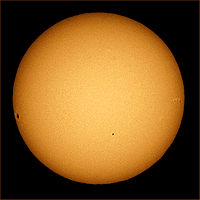
Edmond Halley realised in 1705 that repeated sightings of a comet were in fact recording the same object, returning regularly once every 75–76 years. This was the first evidence that anything other than the planets orbited the Sun. Around this time (1704), the term "Solar System" first appeared in English.
In 1781, William Herschel was looking for binary stars in the constellation of Taurus when he observed what he thought was a new comet. In fact, its orbit revealed that it was a new planet, Uranus, the first ever discovered.
Giuseppe Piazzi discovered Ceres in 1801, a small world between Mars and Jupiter that initially was considered a new planet. However, subsequent discoveries of thousands of other small worlds in the same region led to their eventual reclassification as asteroids.
By 1846, discrepancies in the orbit of Uranus led many to suspect a large planet must be tugging at it from farther out. Urbain Le Verrier's calculations eventually led to the discovery of Neptune. The excess perihelion precession of Mercury's orbit led Le Verrier to postulate the intra-Mercurian planet Vulcan in 1859, but that would turn out to be a red herring.
While it is debatable when the Solar System was truly "discovered," three 19th century observations determined its nature and place in the universe beyond reasonable doubt. First, in 1838, Friedrich Bessel successfully measured a stellar parallax, an apparent shift in the position of a star created by the Earth's motion around the Sun. This was not only the first direct, experimental proof of heliocentrism, but also revealed, for the first time, the vast distance between our Solar System and the stars. Then, in 1859, Robert Bunsen and Gustav Kirchhoff, using the newly invented spectroscope, examined the spectral signature of the Sun and discovered that it was composed of the same elements as existed on Earth, establishing for the first time a physical link between the Earth and the heavens. Then, Father Angelo Secchi compared the spectral signature of the Sun with those of other stars, and found them virtually identical. The realisation that the Sun was a star led to the hypothesis that other stars could have systems of their own, though this was not to be proven for nearly 140 years.
Further apparent discrepancies in the orbits of the outer planets led Percival Lowell to conclude that yet another planet, " Planet X", must lie beyond Neptune. After his death, his Lowell Observatory conducted a search which ultimately led to Clyde Tombaugh's discovery of Pluto in 1930. Pluto was, however, found to be too small to have disrupted the orbits of the outer planets, and its discovery was therefore coincidental. Like Ceres, it was initially considered to be a planet, but after the discovery of many other similarly sized objects in its vicinity it was reclassified in 2006 as a dwarf planet by the IAU.
In 1992, the first evidence of a planetary system other than our own was discovered, orbiting the pulsar PSR B1257+12. Three years later, 51 Pegasi b, the first extrasolar planet around a Sunlike star, was discovered. As of 2008, 221 extrasolar systems have been found.
Also in 1992, astronomers David C. Jewitt of the University of Hawaii and Jane Luu of the Massachusetts Institute of Technology discovered (15760) 1992 QB1. This object proved to be the first of a new population, which came to be known as the Kuiper belt; an icy analogue to the asteroid belt of which such objects as Pluto and Charon were deemed a part.
Mike Brown, Chad Trujillo and David Rabinowitz announced the discovery of Eris in 2005, a scattered disc object larger than Pluto and the largest object discovered in orbit round the Sun since Neptune.
Observations by spacecraft
Since the start of the Space Age, a great deal of exploration has been performed by robotic spacecraft missions that have been organized and executed by various space agencies.
All planets in the Solar System have now been visited to varying degrees by spacecraft launched from Earth. Through these unmanned missions, humans have been able to get close-up photographs of all of the planets and, in the case of landers, perform tests of the soils and atmospheres of some.
The first manmade object sent into space was the Soviet satellite Sputnik 1, launched in 1957, which successfully orbited the Earth for over a year. The American probe Explorer 6, launched in 1959, was the first satellite to image the Earth from space.
Flybys
The first successful probe to fly by another Solar System body was Luna 1, which sped past the Moon in 1959. Originally meant to impact with the Moon, it instead missed its target and became the first manmade object to orbit the Sun. Mariner 2 was the first probe to fly by another planet, Venus, in 1962. The first successful flyby of Mars was made by Mariner 4 in 1965. Mercury was first encountered by Mariner 10 in 1974.
The first probe to explore the outer planets was Pioneer 10, which flew by Jupiter in 1973. Pioneer 11 was the first to visit Saturn, in 1979. The Voyager probes performed a grand tour of the outer planets following their launch in 1977, with both probes passing Jupiter in 1979 and Saturn in 1980 – 1981. Voyager 2 then went on to make close approaches to Uranus in 1986 and Neptune in 1989. The Voyager probes are now far beyond Neptune's orbit, and are on course to find and study the termination shock, heliosheath, and heliopause. According to NASA, both Voyager probes have encountered the termination shock at a distance of approximately 93 AU from the Sun.
The first flyby of a comet occurred in 1985, when the International Cometary Explorer (ICE) passed by the comet Giacobini-Zinner, while the first flybys of asteroids were conducted by the Galileo space probe, which imaged both 951 Gaspra (in 1991) and 243 Ida (in 1993) on its way to Jupiter.
No Kuiper belt object has yet been visited by a spacecraft. Launched on January 19 2006, the New Horizons probe is currently en route to becoming the first man-made spacecraft to explore this area. This unmanned mission is scheduled to fly by Pluto in July 2015. Should it prove feasible, the mission will then be extended to observe a number of other Kuiper belt objects.
Orbiters, landers and rovers
In 1966, the Moon became the first Solar System body beyond Earth to be orbited by an artificial satellite ( Luna 10), followed by Mars in 1971 ( Mariner 9), Venus in 1975 ( Venera 9), Jupiter in 1995 ( Galileo), the asteroid 433 Eros in 2000 ( NEAR Shoemaker), and Saturn in 2004 ( Cassini–Huygens). The MESSENGER probe is currently en route to commence the first orbit of Mercury in 2011, while the Dawn spacecraft is currently set to orbit the asteroid Vesta in 2011 and the dwarf planet Ceres in 2015.
The first probe to land on another Solar System body was the Soviet Luna 2 probe, which impacted the Moon in 1959. Since then, increasingly distant planets have been reached, with probes landing on or impacting the surfaces of Venus in 1966 ( Venera 3), Mars in 1971 ( Mars 3, although a fully successful landing didn't occur until Viking 1 in 1976), the asteroid 433 Eros in 2001 ( NEAR Shoemaker), and Saturn's moon Titan ( Huygens) and the comet Tempel 1 ( Deep Impact) in 2005. The Galileo orbiter also dropped a probe into Jupiter's atmosphere in 1995; since Jupiter has no physical surface, it was destroyed by increasing temperature and pressure as it descended.
To date, only two worlds in the Solar System, the Moon and Mars, have been visited by mobile rovers. The first rover to visit another celestial body was the Soviet Lunokhod 1, which landed on the Moon in 1970. The first to visit another planet was Sojourner, which travelled 500 metres across the surface of Mars in 1997. The only manned rover to visit another world was NASA's Lunar rover, which travelled with Apollos 15, 16 and 17 between 1971 and 1972.
Manned exploration
Manned exploration of the Solar System is currently confined to Earth's immediate environs. The first human being to reach space (defined as an altitude of over 100 km) and to orbit the Earth was Yuri Gagarin, a Soviet cosmonaut who was launched in Vostok 1 on April 12, 1961. The first man to walk on the surface of another Solar System body was Neil Armstrong, who stepped onto the Moon on July 21, 1969 during the Apollo 11 mission; five more Moon landings occurred through 1972. The United States' Space Shuttle, which debuted in 1981, is the only reusable spacecraft to successfully make multiple orbital flights. The five shuttles that have been built have flown a total of 121 missions, with two of the craft destroyed in accidents. The first orbital space station to host more than one crew was NASA's Skylab, which successfully held three crews from 1973 to 1974. The first true human settlement in space was the Soviet space station Mir, which was continuously occupied for close to ten years, from 1989 to 1999. It was decommissioned in 2001, and its successor, the International Space Station, has maintained a continuous human presence in space since then. In 2004, SpaceShipOne became the first privately funded vehicle to reach space on a suborbital flight. That same year, U.S. President George W. Bush announced the Vision for Space Exploration, which called for a replacement for the aging Shuttle, a return to the Moon and, ultimately, a manned mission to Mars.
